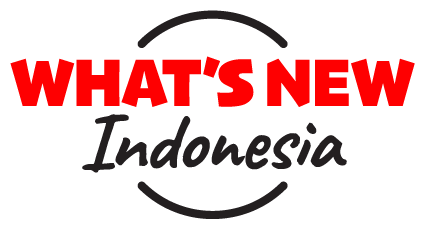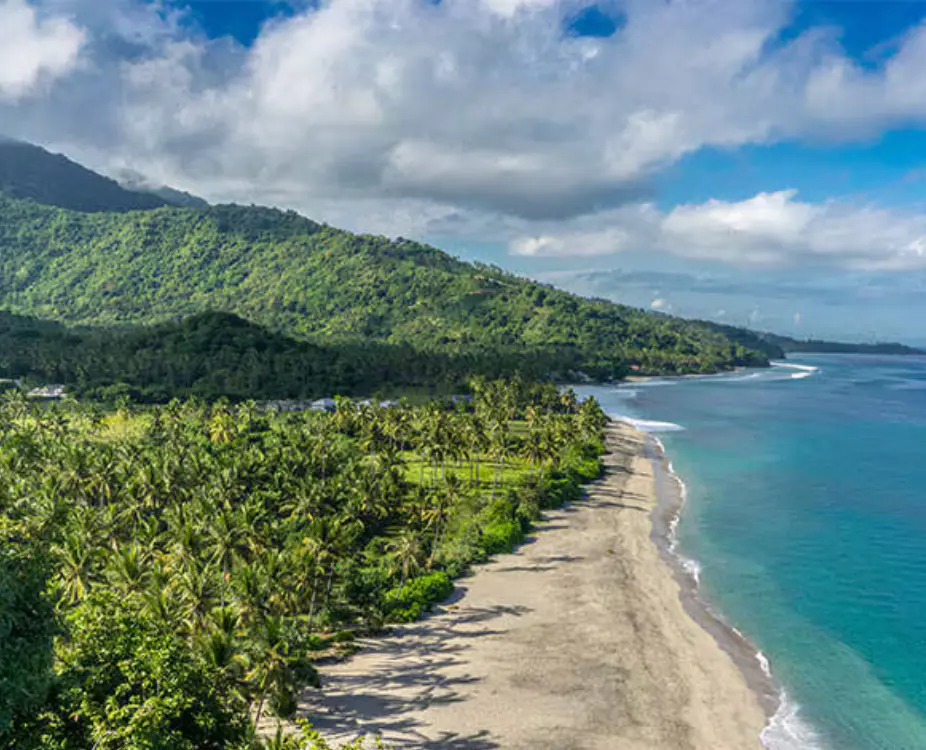Where Culture Dances, Nature Roars, and Time Slows
Lombok is an enchanting island escape in Indonesia. Often overshadowed by its notable neighbour, Bali, Lombok is a hidden gem waiting to be explored. But don’t let its “little sister” status fool you—this island is bursting with rich culture, dazzling landscapes, and a few surprises that might just make it your new favourite destination.
Where does the name "Lombok" come from? No one can quite agree on its meaning. So that depends on who you ask. Some say it comes from the Sasak language, where it means "lurus" or "straight"—possibly referring to a straight path or direction. Others point out that "Lombok" is also the Indonesian word for chilli, leading to a popular theory that the island is named for its spicy food culture. Either way, the name packs a punch, just like its cuisine.
Attractions and cultural highlights
This idyllic island paradise invites you to immerse yourself in its myriad of unforgettable experiences. You can get a taste of the saltwater, mountainous beauty, tradition, and more!
A legendary line separates Lombok from Bali
The narrow stretch of sea between Bali and Lombok—called the Lombok Strait—is more than just a body of water. It’s part of the Wallace Line, a famous biogeographical boundary that separates the animal species of Asia and Australasia. Named after explorer and naturalist Alfred Russel Wallace (who independently developed the theory of evolution alongside Darwin), this invisible line means you’ll find wildlife in Lombok that you won’t see just across the water in Bali. Pretty wild, right?
Beach-hopping in South Lombok
South Lombok is a treasure trove of unspoiled coastlines—the kind where your biggest decision is whether to order another coconut or go for a swim. Base yourself in Kuta, rent a scooter, and set off on a beach-hopping adventure where every stop feels like your own private paradise.
- Tanjung Aan is social but chill. Popular but never overwhelming, the soft white sand, clear water, and bamboo warungs with drinks, snacks, and loungers make this beach ideal for reading, sunbathing, or sipping a coconut with your feet in the sand.
- Pantai Tampah is quiet, clean, and peaceful; a haven for those craving serenity with a view. You'll find a handful of warungs, gentle waves, and plenty of space to relax. It’s ideal for a peaceful swim, lounging in the sun, and soaking in the natural beauty without interruption.
- Pantai Lancing is secluded and soulful. With limited warungs and barely another soul in sight, a sea swing adds a charming touch. It’s a blissful spot for reading, swimming, and enjoying solitude.
- Pantai Semeti is nature's sculpture garden; wild, rugged, and ready to explore. Hidden away and perfect for adventurous souls, Pantai Semeti has dramatic rock formations, a hidden cove, and even a cave if you can find it. It’s not a lounging beach, but more of a natural playground where you can explore.
“Gili” merely means “Island”
You’ve probably heard of the Gili Islands—Trawangan, Meno, and Air—famous for their laid-back buzz and crystal-clear waters. But here’s a fun fact: Gili literally means “small island” in the local language. While those three are the most developed and tourist-friendly, Lombok is actually surrounded by dozens of other “gilis”, each offering its own slice of paradise. So if you’re craving adventure (and fewer crowds), it’s time to start exploring beyond the big three.
Local cuisine to try
Don’t leave Lombok without tasting its bold and spicy cuisine. A few must-tries after a salty day by the sea or shaking from conquering Rinjani, include Ayam Taliwang, grilled chicken marinated in spicy sambal that's smokey, fiery, and iconic to Lombok; the juicy, marinated skewers called Satay Rembiga, grilled to perfection and packed with flavour; fresh catch of the day available at beachside warungs and restaurants often cooked over coconut husks; and a flavour explosion of shredded spicy chicken, white rice, crispy tempeh, and sambal known as Nasi Balap Puyung.
Lombok has three pink beaches
Move over, white sand. Lombok is blushing with not one, but three pink sand beaches, the most famous being Tangsi Beach on the southeast coast. The pink hue comes from tiny red organisms that grow on dead coral, blending with the sand to create a surreal, rose-tinted shoreline. As the sun sets, the contrast between the soft pink sand and turquoise water is absolutely spellbinding.
Meet the Sasak people, Lombok’s indigenous inhabitants
The Sasak people call Lombok their home, scattered on the main island as well as the nearby Gili Islands. They embrace rich traditions and a distinct identity that shape much of the island’s cultural flavour, primarily divided into two spiritual communities: Wektu Lima (follows orthodox Islam) and Wektu Telu (practices blend Islam with elements of Hinduism, Buddhism, and animism).
Mount Rinjani is a hiker’s dream (and a serious challenge)
Towering at 3,726 metres, Mount Rinjani is Indonesia’s second-highest volcano, just behind Mount Kerinci in Sumatra. It's not just tall—it's epic. Trekking to the summit is no stroll in the park. Most climbers need at least three days, camping on the slopes and rising early to catch sunrise from the top. But the views? Absolutely worth it.
Sea Worms are a culinary celebration
Yes, you read that right. Every February, locals gather at Kuta Beach in South Lombok to celebrate Bau Nyale, a centuries-old sea worm festival. As the sea glows with spawning marine worms, traditional dancers, musicians, and a local dukun (spiritual healer) lead ceremonies to predict the prosperity of the coming year. Afterward? Locals collect the worms and cook them with coconut and spices, wrapped in banana leaves. It’s not just a snack—it’s a cultural experience.
Getting There
Reaching Lombok is accessible by air, for the fastest and most convenient option, and by sea, which's the scenic route.
Option 1: Fly into the island's main airport, Lombok International Airport (LOP) in Praya. is the main airport on the island. The airport is about 40 minutes to an hour from Kuta Lombok and about 1.5 hours from Senggigi. You can take a taxi, airport shuttle, or arrange transport through your accommodation. Direct flights are available from:
- Denpasar, Bali, for approximately 30 minutes
- Jakarta for roughly 2 hours
- Surabaya, Yogyakarta, and other major Indonesian cities — duration varies
- Some direct flights from Kuala Lumpur or Singapore may be available seasonally
Option 2: You can take a fast boat departing from Bali's Padang Bai or Serangan Harbour to the Gili Islands or Senggigi. The trip duration is 1.5 to 2.5 hours. Or, cruise on a public ferry for a budget-friendly but slower-around trip lasting between four and five hours (sometimes longer) from Padang Bai to Lombok's Lembar Port. Keep in mind that sea travel can be rough during the rainy season. If you're prone to seasickness, flying might be the better option.
Best Time to Visit Lombok
Dry Season (Best time): May to September — sunny days, calm seas, and ideal weather for outdoor activities. July and August are high season, so expect more tourists—especially on the Gilis.
Rainy Season: November to March — fewer tourists and lush green landscapes, but some tours (especially hikes) may be restricted.
Shoulder Season: April and October — Great balance of good weather and fewer crowds, with slightly lower prices on accommodations and tours.
Accommodations
Luxury resorts: Best Luxury Resorts in Lombok
Mid-range hotels: Best Hotels and Resorts Around Mandalika Circuit, Lombok
Budget-friendly options: Guesthouses and homestays
Lombok travel essentials
1. Time your trip right. The dry season is best for beaches, trekking, and island-hopping. If you're planning to hike Mount Rinjani, avoid the rainy season when trails can be closed for safety.
2. Modest clothing is appreciated, particularly when visiting traditional homes or religious sites, especially in Sasak villages. Cover your shoulders and knees and remove your shoes when entering someone’s home or a mosque.
3. Don’t underestimate Rinjani because it is no casual hike. Bring sturdy hiking shoes, warm layers (it gets cold at the summit), and plan for a multi-day trek with a local guide and porters.
4. Cash is crucial as many areas outside tourist hubs like Senggigi and Kuta have limited ATM access, and small warungs, homestays, and local shops often accept cash only.
5. Go beyond the Gilis. They're exquisite, but Lombok’s mainland is full of uncrowded beaches, waterfalls, and rich cultural experiences. Consider exploring Tetebatu, Senaru, or the Sasak weaving villages.
6. Island-hop smartly. If visiting the Gilis or the Sekotong region, pack reef-safe sunscreen, a dry bag, and snorkelling gear (if you want to avoid using shared equipment). Boats are frequent, but schedules can be affected by the weather.
7. Mind the motorbikes. Renting a scooter is a great way to explore, but roads can be steep, potholed, or sandy, especially in rural areas. Wear a helmet, have an international driving permit, and only ride if you're experienced.
8. Bring bug protection since mosquitoes can be pesky, especially at dusk or in jungle areas. Also, consider a light long-sleeved shirt for extra coverage.
9. Support local artisans and eco-tourism by purchasing handmade Sasak textiles, pottery, or organic soaps, and choose tour operators that practice sustainable and community-based tourism.
10. Stay flexible. Island life runs at its own pace; boats may be late, Wi-Fi can be slow, and plans might change. Embrace the slower rhythm, and Lombok will reward you with unforgettable moments.
Lombok is a must-visit destination for travellers drawn to untamed landscapes, rich cultural traditions, or the quiet charm of an island escape beyond the usual path. Would you give Lombok a go? Read our related articles below for more details.
Best Restaurants and Bars in Lombok With Stunning View 2025
Best Underwater Structures Around Bali - Lombok





 Apr 22, 2025
Apr 22, 2025